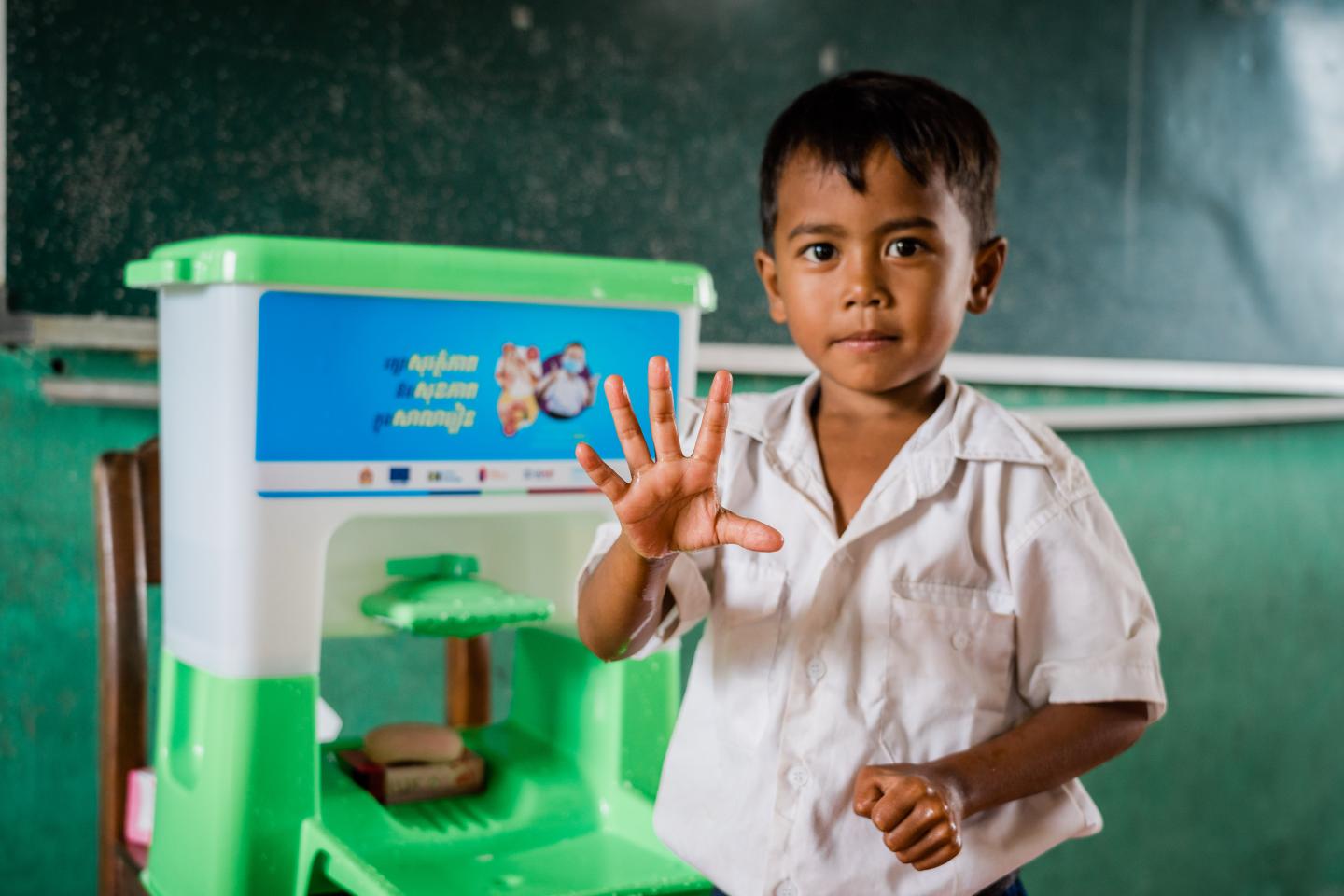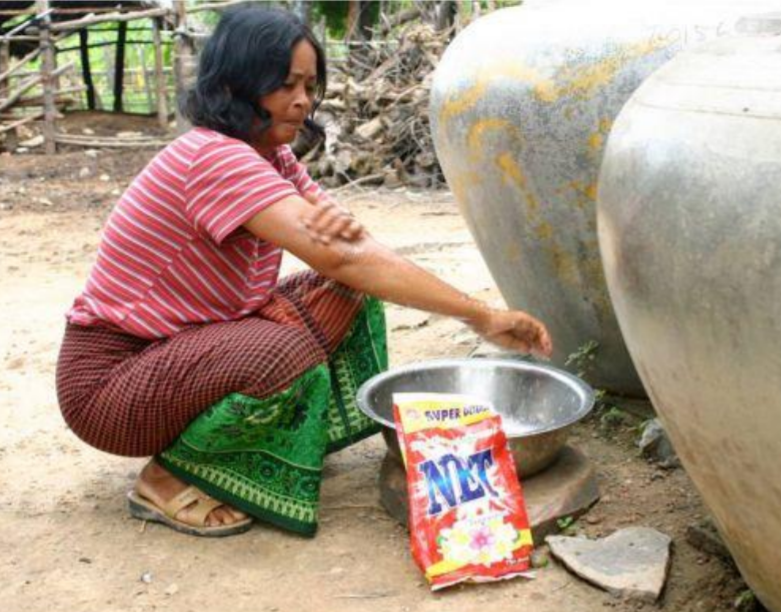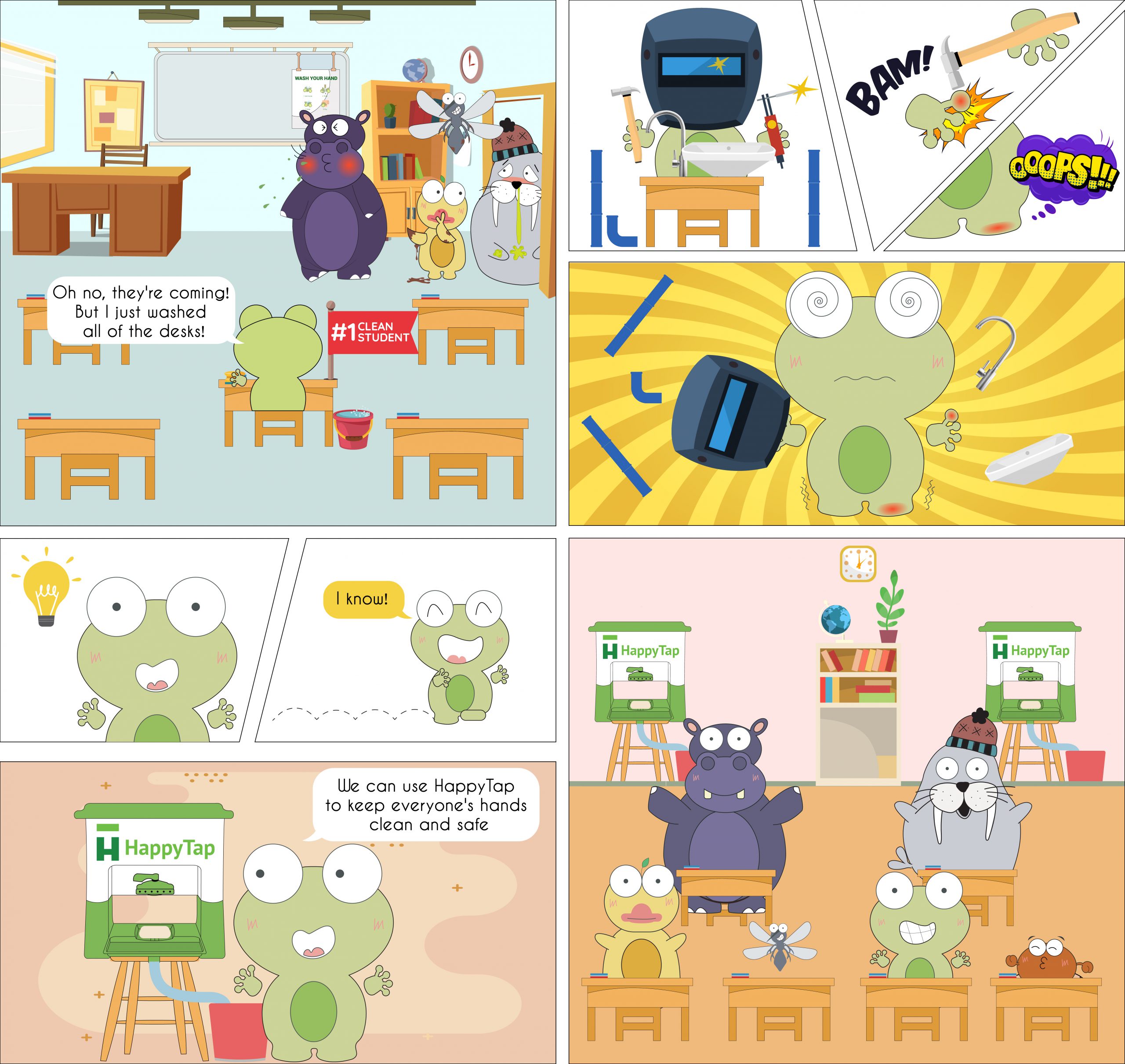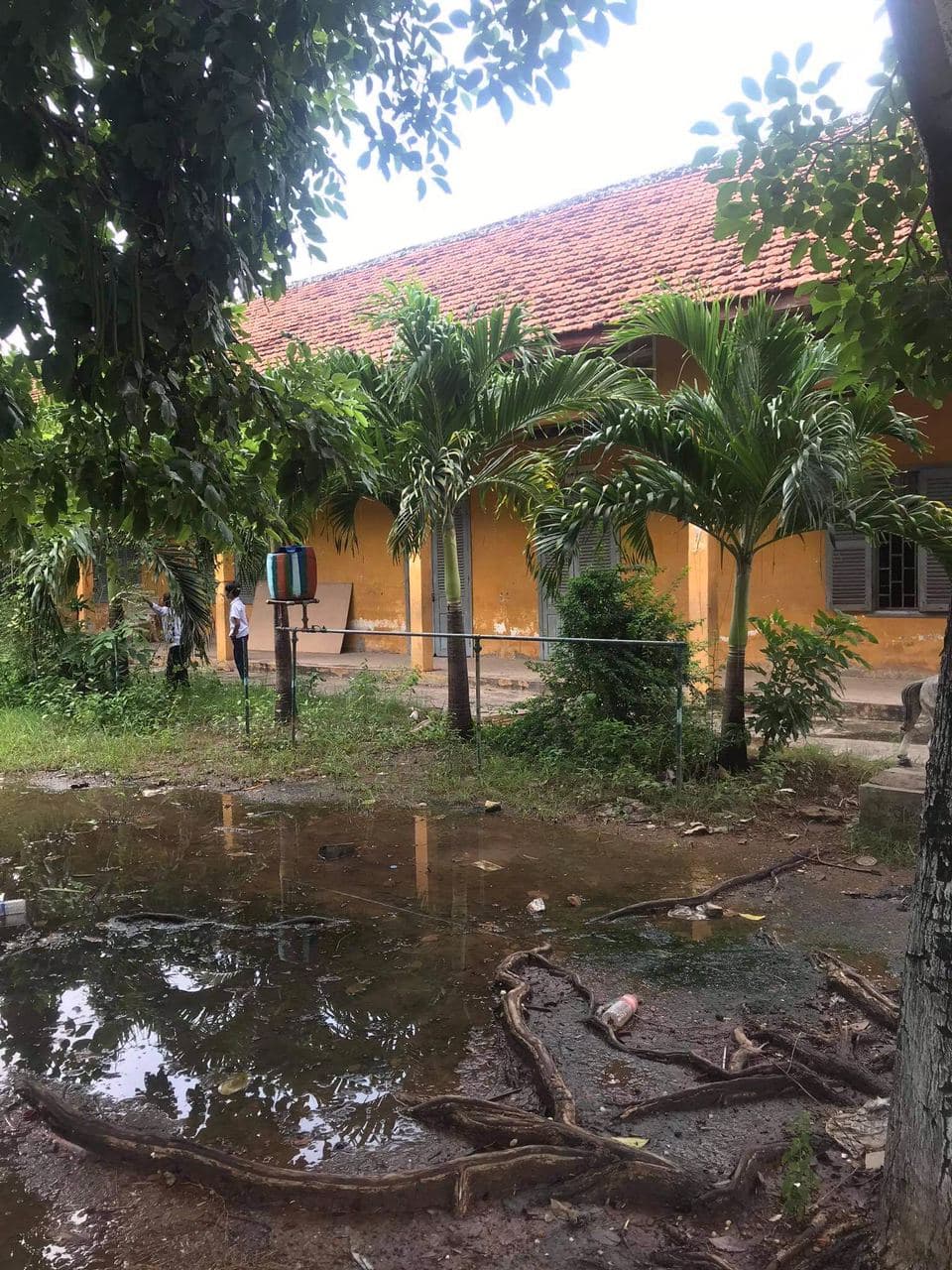An Old Idea about Handwashing is New Again / គំនិតចាស់មួយនៃការលាងសម្អាតដៃ ឥឡូវក្លាយជាថី្មម្តងទៀតហើយ!

A student in Kampot, Cambodia washes hands with HappyTap inside of the classroom (Photo credit: UNICEF Cambodia/2020/Antoine Raap)
(Khmer below)
Did you know, the SHED in WaterSHED stands for sanitation, hygiene enterprise development. Our most in-depth work on hygiene enterprise development has been with HappyTap. Seeing several hygiene projects in R&D this year, we want to share our thinking behind this product and a bit about a company finding itself in the spotlight today.
In 2010, WaterSHED set out to tackle one of the most frustrating public health conundrums: despite a high level of awareness of the benefits of handwashing with soap, actual practice is very low. In 2014, only 19% of the global population was estimated to consistently wash hands with soap after contact with feces (Freeman et al. 2014). Yikes.
Our formative research pointed to a key problem—one that is now gaining attention with COVID-19: the sheer lack of handwashing facilities.
A recent systematic review of studies on the determinants of handwashing behaviour found:
“…the greatest opportunity to improve handwashing with soap may be to ensure access to a desirable and conveniently-located handwashing facility, with soap and water present. …this is likely to be effective because handwashing infrastructure acts as a cue or reminder for handwashing with soap and works to overcome some of the psychological trade-offs that may prevent handwashing (such as perceived effort, and feeling busy or tired).”
Ten years ago, we were curious.
What was the problem with the way people were expected to wash their hands? What could be a game changer at a meaningful scale?

Filling a basin or bowl with water from an outdoor storage jar using a dipper or bowl, and immersing hands into the basin to wash and then re-filling the bowl from the storage jar, often several times, can contaminate a family’s store of drinking water.
Dr. Mimi Jenkins from UC Davis helped us study the typical handwashing practice and equipment in rural Cambodia. Two key findings : most households did not have dedicated handwashing equipment or stations, and over half of the consumers had thought about building or buying equipment to use just for handwashing.
Leading a consortium of partners and an intensive user-feedback & testing process, WaterSHED developed the HappyTap, the leading commercial handwashing sink designed to nudge safer handwashing behavior. Nudge how? Its portability means that it can be easily set up to insert water, soap, and a basin into an existing routine. Finished using the toilet? Wash your hands at the door. Getting ready to cook? Wash your hands next to the cutting board.
To our delight, rural consumers loved their HappyTaps. For some, it created the experience of an indoor sink they saw in health clinics and on TV, but without the need for indoor plumbing.
HappyTaps in schools and clinics

HappyTap’s features have become unexpectedly advantageous when considering what is available for schools or clinics in a pandemic. If you were responsible for procuring thousands of handwashing stations, you would have to decide:
- a ready product or a construction project:
- order a standardized, all-in-one solution with greywater management and minimal setup;
or - plan, fund, and oversee a series of expensive construction
projects

Taps without water catchment can create standing water that is attractive for mosquitoes, and mud that dissuades students from washing hands – such as this handwashing station at a school in Cambodia (photo: Nov 2020)
- order a standardized, all-in-one solution with greywater management and minimal setup;
- multiple portable basins or a single fixed-place station:
- place smaller basins that prompt handwashing next to every two to three patient beds; stations that can be used and filled in rotation;
or - fill one large water drum with taps located outside the health clinic
- place smaller basins that prompt handwashing next to every two to three patient beds; stations that can be used and filled in rotation;
- durable, fit-for-purpose product or a bucket that can be easily repurposed:
- conserve water with a low-flow sprinkler tap and safely contain greywater;
or - let greywater splash down to the ground through a high-flow spigot until the station is abandoned and later becomes the mop bucket
- conserve water with a low-flow sprinkler tap and safely contain greywater;
In 2020, we are impatient.
There is a persistent gap between knowing and doing. Let’s fix it. Before the next pandemic.
There must be handwashing facilities at key handwashing points—classrooms, bathrooms, daycare centers, health clinic waiting areas, meeting rooms, household entrances, kitchens, etc. In low-income countries, there are some 50-90 million handwashing stations missing in schools alone.
HappyTap Co. is partnering with like-minded agencies and governments rising to the immense challenge, including Thrive Networks, BRAC, UNICEF, World Vision, IOM, World Food Program, Durham County in the UK, as well as Ministries of Education and Health in various countries. However, this is only a start. Reach out to the HappyTap team: info@happytap.net, or if you’re avoiding your inbox, you can use their contact form.

Washing hands inside of the classroom!
We will leave it here with this sobering thought from UNICEF and WHO:
“…the majority of people in the least developed countries are at immediate risk of COVID-19 infection due to a lack of hand hygiene facilities. In the 60 highest-risk countries, 2 out of 3 people – 1 billion people in total – lack basic handwashing facilities with soap and water at home. Around half are children… We cannot overstate the threat.”
Many institutional settings are also without hygiene facilities. Forty-seven percent of schools do not have a handwashing facility with water and soap which affects 900 million school-age children. Additionally, 16 percent of healthcare facilities, or around 1 in 6, lack hand hygiene facilities where patients receive care, as well as soap and water at toilets.” — joint statement by Henrietta Fore, Executive Director of UNICEF, and Dr. Tedros Adhanom Ghebreyesus, Director-General of WHO.
តើអ្នកដឹងទេថា កន្ទុយពាក្យ «សេដ» (SHED) នៃឈ្មោះអង្គការវ័តធើសេដ ជាភាសាអង់គ្លេសតំណាងអោយការអភិវឌ្ឈសហគ្រាសអនាម័យ (Sanitation, Hygiene Enterprise Development)។ ការងារស៊ីជម្រៅរបស់យើងដែលផ្តោតលើការអភិវឌ្ឈសហគ្រាសអនាម័យលាងសម្អាត គឺធុងលាងសម្អាតដៃ HappyTap ដោយឃើញថាមានគម្រោងអនាម័យលាងសម្អាតមួយចំនួនក្នុងផ្នែកសិក្សាស្រាវជ្រាវនិងអភិវឌ្ឈ យើងចង់ចែករំលែកអំពីការគិតរបស់យើងពីក្រោយការបង្កើតផលិតផលនេះ និង អំពីក្រុមហ៊ុនរបស់យើងដែលទទួលបានចំណាប់អារម្មណ៍ជាសាធារណៈ ក្នុងពេលបច្ចុប្បន្ន។
ក្នុងឆ្នាំ២០១០ អង្គការវ័តធើសេដបានចាប់ផ្តើមដោះស្រាយបញ្ហាសុខភាពសាធារណៈដែលលំបាកស្មុកស្មាញមួយគឺ៖ ទោះជាការយល់ដឹងអំពីសារៈសំខាន់នៃការលាងសម្អាតដៃជាមួយសាប៊ូមានកម្រិតខ្ពស់ក៏ដោយ តែការអនុវត្តជាក់ស្តែងនៅមានកម្រិតទាបខ្លាំង។ ក្នុងឆ្នាំ២០១៤ មានប្រហែល១៩%នៃប្រជាជនសរុបទូទាំងសកលលោកប៉ុណ្ណោះ ដែលបានត្រូវរាយការណ៍ថាលាងសម្អាតដៃជាមួយសាប៊ូជាប្រចាំ ក្រោយពីបន្ទោរបង់រួច (Freeman et al. 2014)។
ការសិក្សាស្រាវជ្រាវរបស់យើងបានចង្អុលដល់បញ្ហាធំមួយដែលកំពុងទទួលការចាប់អារម្មណ៍ ខណៈពេលនៃការរីករាលដាលនៃជម្ងឺកូវីដ១៩ គឺ៖ កង្វះខាតខ្លាំងនៃកន្លែងលាងសម្អាតដៃ។
កាលពីថ្មីៗនេះ ការសិក្សាបែបពិនិត្យឡើងវិញជាប្រព័ន្ធនៃឯកសារផ្សេងៗអំពីកត្តាជម្រុញនៃការអនុវត្តការលាងសម្អាតដៃ បានរកឃើញដូច្នេះថា៖
«…ឪកាសដ៏ធំបំផុតសម្រាប់កែលម្អអោយមានការលាងសម្អាតដៃជាមួយសាប៊ូ ប្រហែលជាអាស្រ័យលើការធ្វើអោយមានកន្លែងលាងដៃមួយដែលគេចង់ប្រើនិងដាក់នៅចំទីតាំងងាយស្រួលប្រើ ដោយមានវត្តមានសាប៊ូនិងទឹក។ …នេះប្រហែលអាចមានប្រសិទ្ធភាព ព្រោះថាហេដ្ឋារចនាសម្ព័ន្ធសម្រាប់ការលាងសម្អាតដៃ ដើរតួជាសញ្ញាឬជាការរំលឹកអោយលាងសម្អាតដៃជាមួយសាប៊ូ និង ធ្វើអោយជំនះបានកត្តាផ្នែកផ្លូវចិត្តផ្សេងៗ (ដូចជា ការគិតថាចំណាយពេលច្រើនក្នុងការធ្វើ និង ការមានអាម្មរណ៍ថារវល់ឬហត់) ដែលអាចរារាំងមិនអោយមានការលាងសម្អាតដៃ។»
កាលពី១០ឆ្នាំមុន យើងចង់ដឹងចង់យល់
តើអ្វីជាបញ្ហានៃទម្លាប់នៃការលាងដៃរបស់ប្រជាពលរដ្ឋ? តើមានអ្វីដែលអាចធ្វើអោយមានបំលាស់ប្តូរទម្លាប់ការលាងដៃរបស់ប្រជាពលរដ្ឋ នៅលើវិសាលភាពដ៏ធំធេងមួយ?
លោកស្រីបណ្ឌិត មីមី ជិនគីន មកពីសាកលវិទ្យាល័យ យូស៊ី ដេវីស បានជួយយើងធ្វើការសិក្សាអំពីការអនុវត្តការលាងដៃរបស់ប្រជាពលរដ្ឋជនបទប្រទេសកម្ពុជា។ មានការរកឃើញសំខាន់ៗ២ចេញពីការសិក្សានេះ៖ ១)ក្រុមគ្រួសារភាគច្រើនមិនមានឧបករណ៍ឬទីតាំងលាងសម្អាតដៃ ដែលពួកគាត់ដាក់ចិត្តកាយប្រើ និង ២) លើសពីពាក់កណ្តាលនៃអតិថិជនបានគិតចង់សាងសង់ឬទិញឧបករណ៍ដើម្បីប្រើប្រាស់ សម្រាប់តែលាងសម្អាតដៃ។
តាមរយៈការដឹកនាំសម្ព័នដៃគូ និងដំណើរការផលិតតាមមតិយោបល់អ្នកប្រើប្រាស់និងសាកល្បងដ៏ខ្លាំងមួយ អង្គការវ័តធើសេដបានអភិវឌ្ឈធុងHappyTapឡើង ដើម្បីជម្រុញទាក់ទាញអោយការអនុវត្តការលាងសម្អាតដៃមានសុវត្ថិភាពជាងមុន។ ហើយសួរថា ជម្រុញទាក់ទាញតាមរបៀបណា? ការអាចចល័តបាននៃធុងនេះមានន័យ វាងាយស្រួលក្នុងការតម្លើងដើម្បីដាក់ទឹក សាប៊ូ និង ធុងទឹកបញ្ចូលទៅក្នុងទម្លាប់នៃការលាងដៃដែលអនុវត្តស្រាប់។ ក្រោយពីបន្ទោរបង់ ឬ មុនរៀបចំចំអិនអាហារ អ្នកប្រើប្រាស់អាចលាងសម្អាតដៃដោយប្រើធុង HappyTap នៅនឹងកន្លែងផ្ទាល់។
«យើងមានការរីករាយខ្លាំង នៅពេលអតិថិជននៅជនបទស្រលាញ់ផលិតផលធុង HappyTap នេះ។ សម្រាប់អតិថិជនខ្លះ ធុងនេះបង្កើតអោយមានជាបទពិសោធន៍ដូចមានអាងលាងដៃក្នុងផ្ទះ ដែលពួកគាត់បានឃើញនៅតាមគ្លីនិក និងតាមទូរទស្សន៍ ប៉ុន្តែដោយមិនបាច់ត្រូវការគ្រឿងបរិក្ខារទាំងនោះទេ។»
ធុង HappyTap នៅតាមសាលារៀន និង មន្ទីរពេទ្យ/គ្លីនិក
លក្ខណៈពិសេសនៃធុង HappyTap បានក្លាយជាប្រយោជន៍ដោយមិនបានគ្រោងទុក ពេលយើងគិតពីជម្រើសផ្សេងដែលមាន សម្រាប់សាលារៀន ឬក៏មន្ទីរពេទ្យ ក្នុងពេលមានការរាតត្បាតជាសកលនៃការចម្លងមេរោគ។ ប្រសិនបើអ្នកទទួលខុសត្រូវទិញឧបករណ៍លាងសម្អាតដៃចំនួនរាប់ពាន់ អ្នកនឹងត្រូវសម្រេចចិត្តលើចំនុចដូចជា៖
- ជ្រើសយកផលិតផលដែលអាចប្រើប្រាស់បានភ្លាមៗ ឬក៏ សាងសង់កន្លែងលាងដៃ៖
- ទិញផលិតផលស្តង់ដារដែលមានដំណោះស្រាយមួយកំប្ល៉េក្នុងនោះ និង មានដំណើរការតម្លើងនិងគ្រប់គ្រងទឹកលាងដៃរួចស្រួល និងសាមញ្ញ
ឬក៏
- រៀបផែនការ ផ្តល់មូនិធិ និង ត្រួតពិនិត្យតាមដានគម្រោងសាងសង់កន្លែងលាងដៃដែលមានតម្លៃថ្លៃ
- អាងដាក់ទឹកដែលចល័តបានចំនួនច្រើន ឬក៏ កន្លែងលាងដៃតែមួយ ដែលនៅមួយកន្លែង
- ដាក់អាងទឹកតូចៗនេះនៅក្បែរគ្រែអ្នកជម្ងឺ (ចន្លោះ២ឬ៣គ្រែដាក់អាងមួយ) ដើម្បីជម្រុញអោយមានការលាងសម្អាតដៃ ហើយធុងលាងដៃអាចចល័តការប្រើប្រាស់និងដកយកទៅបំពេញទឹកបាន
ឬក៏
- បំពេញទឹកក្នុងធុងស្តុកដ៏ធំមួយជាមួយគម្រប ដែលដាក់នៅក្រៅមន្ទីរពេទ្យឬគ្លីនិក
- ផលិតផលដែលជាប់ធន់និងចំតម្រូវការ ឬក៏ ធុងទឹកធម្មតា
- អាចសន្សំសំចៃទឹកបាន ដោយក្បាលរ៉ូប៉ីនេបង្ហូរទឹកបង្ហូរទឹកចេញតិចៗ និងអាចទុកដាក់ទឹកដែលលាងដៃរួចអោយមានសុវតិ្ថភាព
ឬក៏
- អោយទឹកលាងដៃហូរចេញទៅដីជាច្រើន ដោយក្បាលរ៉ូប៉ីនេបង្ហូរទឹកបង្ហូរទឹកចេញច្រើន រហូតធុងលាងដៃលែងបានប្រើប្រាស់បន្តទៀត
សម្រាប់ឆ្នាំ២០២០ យើងលែងមានការអត់ធ្មត់ទៀតហើយ
គម្លាតរវាងការយល់ដឹងនិងការធ្វើជាក់ស្តែងនៅតែបន្តមាន ដូច្នេះយើងត្រូវដោះសា្រយវាទាំងអស់គ្នា មុននឹងមានការរីករាលដាលជម្ងឺជាសកលម្តងទៀត។
ឧបករណ៍លាងសម្អាតដៃចាំបាច់ត្រូវតែមាន នៅគ្រប់ចំនុចលាងដៃសំខាន់ៗដូចជា ថ្នាក់រៀន បន្ទប់ទឹក មណ្ឌលថែក្មេង កន្លែងរង់ចាំក្នុងមន្ទើរពេទ្យ/គ្លីនិក បន្ទប់ប្រជុំ មុខផ្ទះ ចង្រ្កានបាយ ។ល៕ នៅក្នុងប្រទេសក្រីក្រ មានកង្វះឧបករណ៍លាងសម្អាតដៃចំនួនពី ៥០ ទៅ ៩០លាន នៅតាមសាលារៀន។
ក្រុមហ៊ុន HappyTap (HappyTap Co.) កំពុងសហការជាមួយភ្នាក់ងារដែលមានការគិតដូចគ្នានិងរដ្ឋាភិបាលដែលកំពុងទប់ទល់នឹងកត្តាប្រឈមយ៉ាងធំ ដូចជា បណ្តាញ ស្រ៉ាវ (Thrives Networks) ប្រែក (BRAC) អង្គការយូនីសេហ្វ អង្គការទស្សនៈពិភពលោក ស្ថាប័នអាយអូអ៊ិម អង្គការស្បៀងអាហារពិភពលោក និង ដឺរហែម ខោនធឺ នៅប្រទេសអង់គ្លេស ក៏ដូចជា ក្រសួងអប់រំ និង ក្រសួងសុខាភិបាល នៅក្នុងជាច្រើនប្រទេស។ ប៉ុន្តែនេះគ្រាន់តែជាការចាប់ផ្តើមប៉ុណ្ណោះ។ អ្នកអាចទាក់ទងមកក្រុមការងារ HappyTap តាមរយៈ៖ info@happytap.net ឬបើអ្នកមិនចង់បានអ៊ីម៉ែលច្រើនក្នុងប្រអប់អ៊ីម៉ែល អ្នកអាចប្រើ ទម្រង់ទាក់ទង នេះបាន។
យើងនឹងបញ្ចប់ប្លុកមួយនេះជាមួយនឹងការគិតដែលចេញពីអង្គការយូនីសេហ្វ និង អង្គការសុខភាពពិភពលោក៖
«…ប្រជាជនភាគច្រើននៅក្នុងប្រទេសក្រីក្របំផុតគឺត្រូវប្រឈមគ្រោះថ្នាក់ភ្លាមៗនៃការឆ្លងមេរោគកូវីដ១៩ ដោយសារតែកង្វះឧបករណ៍លាងសម្អាតដៃ។ នៅក្នុងប្រទេស៦០ដែលប្រឈមគ្រោះថ្នាក់នេះខ្ពស់បំផុត (ដែលសរុបប្រជាជនទាំងអស់ប្រហែល១ពាន់លាននាក់) មានមនុស្ស២ក្នុងចំណោម៣នាក់ដែលគ្មានកន្លែងឬឧបករណ៍លាងសម្អាតដៃជាមួយទឹកនិងសាប៊ូនៅក្នុងផ្ទះ។ ជាងពាក់កណ្តាលនៃប្រជាជនជាកូនក្មេង…យើងមិនរៀបរាប់ពីគ្រោះថ្នាក់អោយហួសកម្រិតនោះទេ។
«មជ្ឈដ្ឋានស្ថាប័នរដ្ឋាភិបាលជាច្រើនក៏ពុំមានកន្លែងឬឧបករណ៍សម្រាប់លាងសម្អាតដៃទេ។ ៧៤%នៃសាលារៀនក្នុងប្រទេសទាំងនេះគ្មានកន្លែងឬឧបករណ៍សម្រាប់លាងសម្អាតដៃ ដែលនេះប៉ះពាល់ដល់៩០០លាននាក់នៃសិស្សដែលជាកូនក្មេង។ បន្ថែមពីនេះទៀត ១៦%នៃមណ្ឌលសុខភាព/មន្ទីរពេទ្យ (ឬក៏១ក្នុង៦) ខ្វះកន្លែង/ឧបករណ៍លាងសម្អាតដៃ នៅក្នុងកន្លែងដែលអ្នកជម្ងឺទទួលបានការព្យាបាល ហើយក៏ខ្វះទឹកនិងសាប៊ូនៅក្នុងបង្អន់ផងដែរ។» – ប្រសាសន៍រួមគ្នា របស់លោកស្រី ហិនរីអាថា ហ្វរ នាយកប្រតិបត្តិប្រចាំអង្គការយូនីសេហ្វ និង លោក វេជ្ជ. តេត្រូ អាណានូម គីប្រីអេស៊ិស ប្រធាននាយកប្រតិបត្តិប្រចាំអង្គការសុខភាពពិភពលោក។
